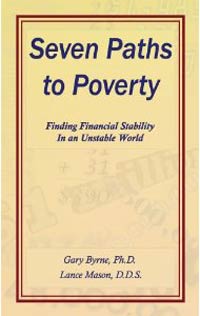Seven Paths to Poverty
S.B. Authors Give Commonsense Advice on Saving Money in New Book
A fool and his money are soon parted, and a sucker is born every minute. Out of these harsh realities, investment executive and business writer Gary Byrne and Santa Barbara dentist Lance Mason have spun Seven Paths to Poverty, a cautionary manual about money, planning, power, and personal responsibility that offers hope for a financial happy ending.
The best way to make money, they write, is to not spend it in the first place. Given the billions spent each year convincing consumers to part with cash, the authors acknowledge adopting more money-conscious habits may not be easy. But with a little willpower, they argue, it would pay off. If most people saved just a little bit every month, invested the proceeds of that savings, and kept doing so for 40 years, they’d be able to retire at age 60 relatively fat and happy.

Written in a conversational voice that’s smart, breezy, and, at times, rambling, Seven Paths reads like a contemporary reformulation of Benjamin Franklin’s Poor Richard’s Almanac, bursting with the sort of commonsense suggestions that are both obvious and frequently ignored. But at its core, Seven Paths is a love song exalting the possibilities posed by compound interest. If people paid close attention to where they spent their money, the authors are confident they’d quickly find $5 a day they could save. That adds up to $35 a week, or $1,825 a year. If you invested just that year’s sum—assuming a 10-percent rate of return—and left it alone for 40 years, it would grow to $85,000. But if the same person continuedsaving that $5 a day and investing it for 40 years, it would grow to $900,000. That most people don’t, Byrne and Mason contend, is because of “media, marketing, and merchandising,” or what they call “the 3 Ms.” Individuals are too quick to surrender what limited power they actually have over their own economic well-being.
The first step to reasserting that power, they write, is to become mindful about money; establish specific achievable goals and put them in writing; make plans for achieving those goals; and put those in writing, too. They acknowledge this won’t work for everyone. But as they say at the book’s beginning, “The pivotal truth behind this book is that nearly all of us, between our teens and retirement, handle enough money to become actual millionaires.”



